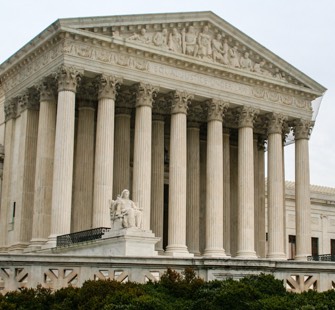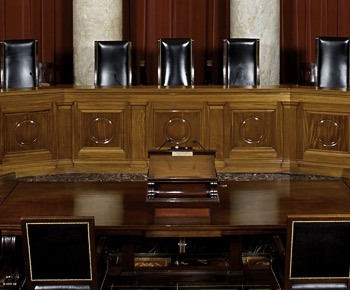Laches no defense to patent infringement during statute of limitations
 The United States Supreme Court recently issued its decision in SCA Hygiene Products Aktiebolag et al. v. First Quality Baby Products, LLC, et al. The issue before the Supreme Court was whether the defense of laches remained a viable defense to patent infringement actions brought during the exceptionally long six-year statute of limitations. The Supreme Court ruled that the defense of laches is inappropriate for claims brought within the statute of limitations, hardly a shocking ruling given that the Court reached the same ruling only several years ago with respect to laches as a defense in copyright infringement claims. See Petrella v. Metro-Goldwyn-Mayer, Inc., 572 U.S. ___ (2014).
The United States Supreme Court recently issued its decision in SCA Hygiene Products Aktiebolag et al. v. First Quality Baby Products, LLC, et al. The issue before the Supreme Court was whether the defense of laches remained a viable defense to patent infringement actions brought during the exceptionally long six-year statute of limitations. The Supreme Court ruled that the defense of laches is inappropriate for claims brought within the statute of limitations, hardly a shocking ruling given that the Court reached the same ruling only several years ago with respect to laches as a defense in copyright infringement claims. See Petrella v. Metro-Goldwyn-Mayer, Inc., 572 U.S. ___ (2014).
Unlike most patent decisions, the decision in SCA Hygiene Products was not unanimous. The majority opinion was delivered by Justice Alito, who was joined by the Chief Justice, as well as Justices Kennedy, Thomas, Ginsburg, Sotomayor, and Kagan. A dissent was filed by Justice Breyer, who would have affirmed the Federal Circuit ruling finding that 35 U.S.C. 282 codified a laches defense without using the term “laches.” It was Justice Breyer’s belief that the codified defense of unenforceability allowed for a laches defense to patent infringement actions, explaining that in very old cases interpreting the common law, laches was at times equated to unenforceability.
SCOTUS asks Director Lee to respond to SCOTUS cert petition
At the end of February, the United States Supreme Court requested a response from Michelle K. Lee, Director of the United States Patent and Trademark Office (USPTO), related to the petition for writ of certiorari filed by Oil States Energy Services, LLC, Petitioner, against Greene’s Energy Group, LLC, et. al. The dispute is between the parties to an inter partes review (IPR) proceeding conducted by the Patent Trial and Appeal Board (PTAB).
There are three questions presented by Oil States in the petition for writ of certiorari:
- Whether inter partes review – an adversarial process used by the Patent and Trademark Office (PTO) to analyze the validity of existing patents – violates the Constitution by extinguishing private property rights through a non-Article III forum without a jury.
- Whether the amendment process implemented by the PTO in inter partes review conflicts with the Court’s decision in Cuozzo Speed Technologies, LLC v. Lee, 136 S.Ct. 2131 (2016), and congressional direction.
- Whether the “broadest reasonable interpretation” of patent claims – upheld in Cuozzo for use in inter partes review – requires the application of traditional claim construction principles, including disclaimer by disparagement of prior art and reading claims in light of the patent’s specification.
03.22.17 | Patent Issues, posts, Supreme Court Cases | Gene Quinn
SCOTUS take patent venue case
 Several weeks ago, the United States Supreme Court granted certiorari in TC Heartland LLC v. Kraft Food Brands Group LLC. This case will force the Supreme Court to decide whether 28 U.S.C. § 1400(b) is the exclusive provision governing venue in patent infringement actions. This resolution of this question could have important ramifications, both for the future of patent litigation and for the future of patent reform.
Several weeks ago, the United States Supreme Court granted certiorari in TC Heartland LLC v. Kraft Food Brands Group LLC. This case will force the Supreme Court to decide whether 28 U.S.C. § 1400(b) is the exclusive provision governing venue in patent infringement actions. This resolution of this question could have important ramifications, both for the future of patent litigation and for the future of patent reform.
Ultimately, the question that the petitioner really wants the Supreme Court to decide is if the Eastern District of Texas, home up to one-quarter of all patent infringement litigations, is a proper venue for patent owners to be choosing. The Eastern District of Texas is a popular choice among patent owners because of the perception that the district court has developed a articular specialty in handling patent matters, and because the judges have a reputation of giving patent owners a fair chance…maybe more than a fair chance, depending upon who you listen to.
If the Supreme Court issues a ruling that strikes down current patent venue rules, there would be no need for patent venue reform efforts to continue in Congress. On the other hand, if the Supreme Court were to affirm the Federal Circuit, calls for legislative venue reform would likely become deafening. On yet a third hand, patent reform might look very different than most people expect, even if the Supreme Court were to overrule the Federal Circuit, because a venue ruling that would make it difficult or impossible to bring cases in the Eastern District of Texas would also make it much more difficult for all patent owners to bring infringement cases in courts other than the home court of the defendant. That could be a bridge too far for many, if not most, patent owners, who otherwise might be in favor of at least some venue reform. Thus, there is a chance that whatever the outcome of this case, it will lead to patent reform. See The Politics of Patent Venue Reform.
The statutes in question will be 28 U.S.C. § 1400(b) and 28 U.S.C. § 1391(c). Pursuant to § 1400(b), a “patent infringement may be brought in the judicial district where the defendant resides, or where the defendant has committed acts of infringement and has a regular and established place of business.” Pursuant to § 1391(c), a corporation is deemed to be a resident of “any judicial district in which such defendant is subject to the court’s personal jurisdiction…”
In Fourco Glass Co. v. Transmirra Products Corp., 353 U.S. 222 (1957), the Supreme Court held that § 1400(b) is not to be supplemented by § 1391(c) and that “§ 1400(b) is the sole and exclusive provision controlling venue in patent infringement actions….” While that might seem to end the inquiry on its face, the Federal Circuit has for 25 years ignored the Supreme Court ruling in Fourco Glass, based on the belief that 1988 amendments by Congress “rendered the statutory definition of corporate residence found in § 1391 applicable to patent cases.” Thus, it is the belief of the Federal Circuit that Congress overruled the Supreme Court’s ruling in Fourco Glass, which Congress obviously has the authority to do. See Supreme Court agrees to hear patent venue case with patent reform implications.
The irony is that everyone knows this case is about the Eastern District of Texas, yet the case between TC Heartland and Kraft Food Brands Group was litigated in the District of Delaware. Thus, Kraft is unfortunately caught up in this proxy patent battle to which it really ought not be a party. It is truly unfortunate that the Supreme Court would use a case from Delaware and party that is most certainly not a patent troll to opine about patent trolls running to the Eastern District of Texas. But that is the bizarro world of patent litigation in which we live, some might say.
01.11.17 | Patent Issues, Patent Litigation, posts, Supreme Court Cases | Gene Quinn
SCOTUS refuses to take Sequenom v. Ariosa
 On June 27, 2016, the United States Supreme Court denied certiorari to Sequenom, Inc., which will let stand a decision of the United States Court of Appeals for the Federal Circuit that ruled a truly revolutionary medical test to be patent ineligible.
On June 27, 2016, the United States Supreme Court denied certiorari to Sequenom, Inc., which will let stand a decision of the United States Court of Appeals for the Federal Circuit that ruled a truly revolutionary medical test to be patent ineligible.
The innovation in question is a test for detecting fetal genetic conditions in early pregnancy that avoided dangerous, invasive testing techniques that are potentially harmful to both the mother and the fetus.
The invention, which was embodied in U.S. Patent No. 6,258,540, claimed certain methods of using cffDNA. The patent teaches technicians to take a maternal blood sample, keep the non-cellular portion (which was “previously discarded as medical waste”), amplify the genetic material that only the inventors had discovered was present, and identify paternally inherited sequences as a means of distinguishing fetal and maternal DNA. The claimed method does not preempt other demonstrated uses of cffDNA.
The Industry Reacts to Cuozzo Speed Technologies v. Lee
 On June 20th, the U.S. Supreme Court handed down a decision in Cuozzo Speed Technologies, LLC v. Lee, which may not have wide-reaching implications on the U.S. patent landscape but will nonetheless be troubling to patent owners. In a unanimous 8-0 decision, the court upheld the ability of the Patent Trial and Appeal Board (PTAB) to apply the broadest reasonable interpretation (BRI) of patent claims during an inter partes review (IPR) proceeding. It also declared that PTAB’s use of the IPR system was not judicially reviewable.
On June 20th, the U.S. Supreme Court handed down a decision in Cuozzo Speed Technologies, LLC v. Lee, which may not have wide-reaching implications on the U.S. patent landscape but will nonetheless be troubling to patent owners. In a unanimous 8-0 decision, the court upheld the ability of the Patent Trial and Appeal Board (PTAB) to apply the broadest reasonable interpretation (BRI) of patent claims during an inter partes review (IPR) proceeding. It also declared that PTAB’s use of the IPR system was not judicially reviewable.
“This is obviously a victory for some who challenge a patent’s validity in IPR proceedings since broadly construed claims are more vulnerable to attack than narrowly construed claims,” remarked Scott Daniels, partner at Westerman Hattori Daniels & Adrian, LLP. “Still, the great majority of IPR decisions do not turn on claim construction and for those cases Cuozzo simply makes no difference.”
06.30.16 | Inter Partes Review, Patent Issues, Supreme Court Cases, USPTO | Gene Quinn


No Comments
04.26.17 | Patent Issues, Patent Litigation, posts, Supreme Court Cases | Gene Quinn